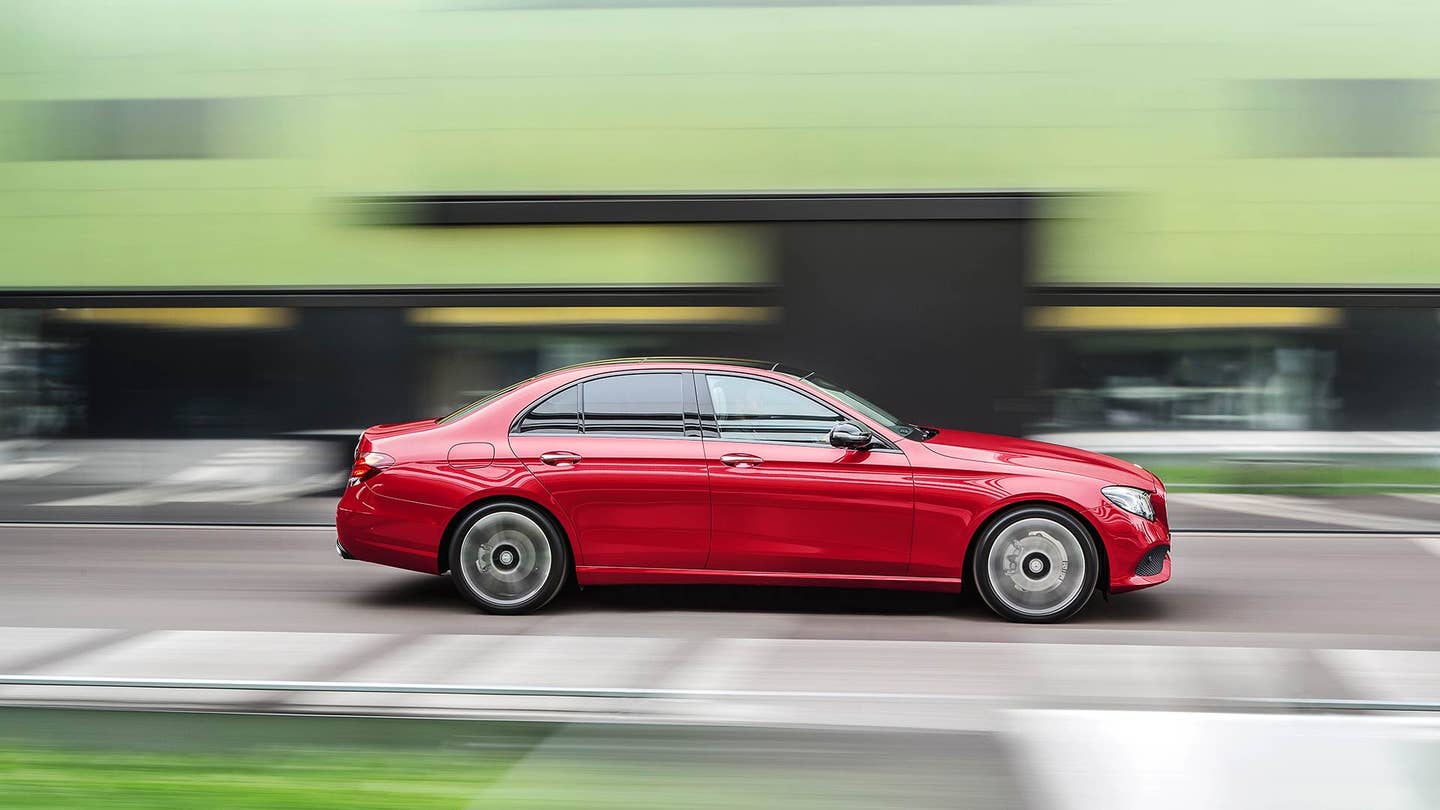Almost, But Not Quite, Crashing the 2017 Mercedes-Benz E300
The high-tech Mercedes E-Class has more than crash-avoidance tricks up its sleeve.

I am sitting in the back seat of an all-new 2017 Mercedes-Benz E300, autonomously cruise-controlling at a steady 60 km/hour—about 37 mph—along the back straight Lisbon’s Estoril racetrack when the inflatable(!) 2017 Mercedes-Benz E300 in front of us suddenly slams on its brakes.
Our driver, a stereotypically humorless German engineer, narrates the experience as we hurtle towards the vinyl sedan's bulbous butt: “My foot is steady to the floor. I am not touching brake or accelerator," she intones. "My foot is steady to the floor.” Using a combination of radar, cameras, and black magic, our car senses an impact and trumpets a series of penetrating bleeps and alarmingly flashes its row of dash-top diodes. Then like an ersatz driver’s ed instructor making a point, the car applies a pulsating, full-force slam of its anti-lock brakes, coming to a complete stop inches from the putative target.
Piñata calamity averted. But this is hardly the E-Class’ only trick. Hosting what I deem the most advanced, functional, and user-friendly suite of autonomous driving technologies in the world, the new E can now also conduct itself, sans driver, along a highway—accelerating, decelerating, centering between lane markers, and steering with remarkable precision—at speeds of up to 130 m.p.h., which is twice as fast as most Americans can legally drive.
It takes over the wheel by following the lines on the road, or a car in front of it, for at least a minute—about as long as it takes to read, and respond to a complex text message (note: don't do this). It adds additional steering torque in emergency maneuvers, like avoiding a downed pedestrian or escaping from the parking lot at Whole Foods. It can talk to other cars, or whichever of our robot overlords it deems its relevant kameraden, via the world’s first Car-To-X communication system. It nudges you into the center of your seat, like an overprotective spouse, where you will better be protected by the cushioning force of its myriad airbags. It can change lanes on its own if you have the requisite intelligence and situational awareness to use the lane change indicator, which most Americans do not. In the event the car senses an impending impact it even emits, we're told, an inaudible noise that stimulates the "stapedius effect" by relaxing a tiny muscle in your inner ear to reduce the chance of hearing damage as $65,000 worth of metal, glass, leather, wood, and gasoline explodes around you.
I didn’t hear anything when we almost crashed into the balloon E-Class. But as with other invisible saviors, like extraterrestrials or god, one cannot by nature disprove the existence of the imperceptible.
If you choose to do all of the driving on your own, the new E is just as rewarding. It's supple yet firm thanks to an available and adjustable air suspension, capable of communicating clear road feel through the new dual touchpad-enabled steering wheel—that lets you swipe through options, like driving mode or radio stations, as you would with a smartphone—and potent enough for all of your executive sedan executive functions thanks to its punchy, turbocharged 2.0-liter 4-cylinder engine and nine-speed transmission. (It clocks in at 241 hp and 273 lb-ft, but more powerful upsells will be available down the line via Mercedes-AMG's twin-turbocharged 3.0-liter V6 E43 and twin-turbocharged 4.0-liter V8 E63 engines.) As in all other aspects of my life, I would like more power. But in the case of the new E, I would likely settle for the smallest engine if only because it’s probably the only one available with an upright three pointed star hood ornament. That’s a necessity.
The exterior styling takes a great leap forward by going backward, to an era of smooth and streamlined simplicity rather than the biomorphic, because-we-can creases and ziggurats of the recent past. It's stately and inoffensive, both of which are meant as compliments.
The interior is similarly satisfying. The E-Class follows its big brother S-Class and its younger brother C-Class in delivering one of our favorite contemporary interior design sensibilities, with a combination of functional advancements like highly resolved dual dash and infotainment screens, and well finished trim in classic leather, chrome, and wood. Some of the material combinations on display at launch were a bit overwrought but, like most problems in the luxury world, this can be written off to poor taste in optioning. Make simple selections and your E will look as elegant as a classic Benz sedan. And if you want to tart it up, just pick one of the more garish of the 64 ambient light color choices available. The neon aubergine and iguana orange clash with almost everything.
I’m a critical bitch with the motto: “If you don’t have anything nice to say, say it louder.” But as with its Benz family sedan-mates I have almost nothing negative to shout about the new E-Class. I do, however, have two tiny quibbles: on the C-Class, the broad center console is available with the same lovely wood trim that accents the dash and door panels, but every E we saw had cheapened this prime real estate by coating it in Piano Black—otherwise known as "Shitty Gloss Plastic." I hope this isn’t indicative of how it will arrive Stateside. Also, since my driving partner and I had around 250 miles to cover in Portugal, I took the opportunity to spend some time in the back seat; while wheelbase has been expanded by some inches over the outgoing model and legroom is plentiful, the rear cushion is a bit short. (Not that I’m going to be sitting back there ever again.)
